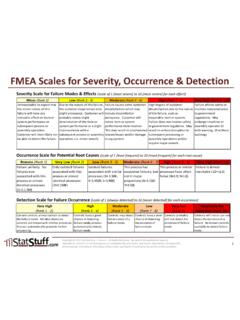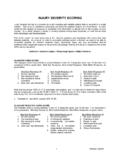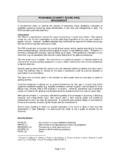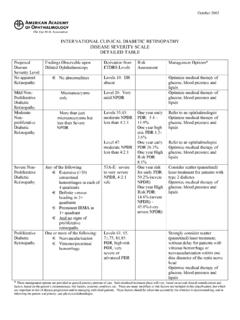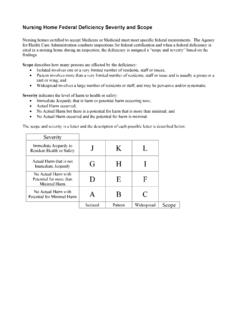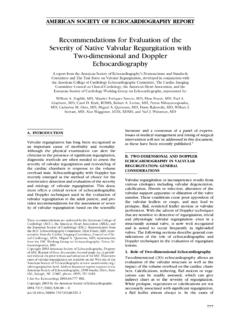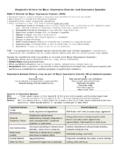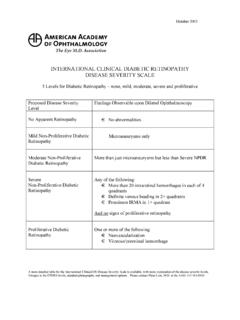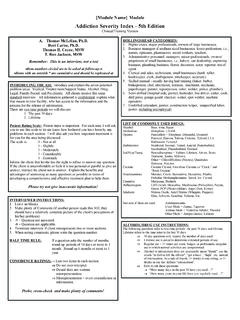Transcription of FMEA Scales for Severity, Occurrence & Detection
1 FMEA Scales for severity , Occurrence & DetectionFMEA Scales for severity , Occurrence & DetectionSeverity scale for Failure Modes & Effects ( scale of 1 [least severe] to 10 [most severe] for each effect) Occurrence scale for Potential Root Causes ( scale of 1 [least frequent] to 10 [most frequent] for each root cause)Minor (Rank 1)Low (Rank 2 - 3)Moderate (Rank 4 - 6)High (Rank 7 - 8)Very High (Rank 9 - 10)Unreasonable to expect that the minor nature of this failure will have any noticable effect on item or system performance or subsequent process or assembly operation. Customer will most likely not be able to detect the to the nature of this failure, the customer experiences only slight annoyance. Customer will probably notice slight deterioration of the item or system performance or a slight inconvenience with a subsequent process or assembly operation, minor causes some customer dissatisfaction which may include discomfort or annoyance.
2 Customer will notice item or system performance deterioration. This may result in unscheduled rework/repair and/or damage to degree of customer dissatisfaction due to the nature of the failure, such as inoperable item or system. Failure does not involve safety or government regulation. May result in serious disruption to subsequent processing or assembly operations and/or require major affects safety or involves noncompliance to government regulations. May endanger machine or assembly operator (9 with warning, 10 without warning)Minor (Rank 1)Low (Rank 2 - 3)Moderate (Rank 4 - 6)High (Rank 7 - 8)Very High (Rank 9 - 10)Unreasonable to expect that the minor nature of this failure will have any noticable effect on item or system performance or subsequent process or assembly operation.
3 Customer will most likely not be able to detect the to the nature of this failure, the customer experiences only slight annoyance. Customer will probably notice slight deterioration of the item or system performance or a slight inconvenience with a subsequent process or assembly operation, minor causes some customer dissatisfaction which may include discomfort or annoyance. Customer will notice item or system performance deterioration. This may result in unscheduled rework/repair and/or damage to degree of customer dissatisfaction due to the nature of the failure, such as inoperable item or system. Failure does not involve safety or government regulation. May result in serious disruption to subsequent processing or assembly operations and/or require major affects safety or involves noncompliance to government regulations.
4 May endanger machine or assembly operator (9 with warning, 10 without warning) Detection scale for Failure Occurrence ( scale of 1 [always detected] to 10 [never detected] for each Occurrence )Copyright 2011 by Matthew J. Hansen. All Rights Reserved. No part of this publication may be reproduced, stored in a retrieval system, or transmitted by any means (electronic, mechanical, photographic, photocopying, recording or otherwise) without prior permission in writing by the author and/or (Rank 1)Very Low (Rank 2)Low (Rank 3 - 5)Moderate (Rank 6 - 7)High (Rank 8 - 9)Very High (Rank 10)Failure unlikely. No failures ever assocaited with this process or almost identical processes (1=1 )Only isolated failures associated with this process or almost identical processes (2=1:150K)Isolated failures associated with similar processes (3= 1:30K; 4=1:4500; 5=1:800)This process has occasional failures, but not in major proportions (6=1:150: 7=1:50)This process or similar processes have often failed (8=1:9; 9=1:6)Failure is almost inevitable (10=>1:3)Remote (Rank 1)Very Low (Rank 2)Low (Rank 3 - 5)Moderate (Rank 6 - 7)High (Rank 8 - 9)Very High (Rank 10)Failure unlikely.
5 No failures ever assocaited with this process or almost identical processes (1=1 )Only isolated failures associated with this process or almost identical processes (2=1:150K)Isolated failures associated with similar processes (3= 1:30K; 4=1:4500; 5=1:800)This process has occasional failures, but not in major proportions (6=1:150: 7=1:50)This process or similar processes have often failed (8=1:9; 9=1:6)Failure is almost inevitable (10=>1:3)Very High (Rank 1 - 2)High (Rank 3 - 4)Moderate (Rank 5 - 6)Low (Rank 7 - 8)Very low (Rank 9)Absolutely No Detection (Rank 10)Current controls almost certain to detect the failure mode. Reliable Detection controls are known with similar processes. Process automatically prevents further have a good chance of detecting failure mode, process automatically detects failure may detect the existence of a failure have a poor chance of detecting the existence of failure modeControls probably will not detect the existence of failure modeControls will not or can not detect the existence of a failure.
6 No known controls available to detect failure High (Rank 1 - 2)High (Rank 3 - 4)Moderate (Rank 5 - 6)Low (Rank 7 - 8)Very low (Rank 9)Absolutely No Detection (Rank 10)Current controls almost certain to detect the failure mode. Reliable Detection controls are known with similar processes. Process automatically prevents further have a good chance of detecting failure mode, process automatically detects failure may detect the existence of a failure have a poor chance of detecting the existence of failure modeControls probably will not detect the existence of failure modeControls will not or can not detect the existence of a failure. No known controls available to detect failure mode.
